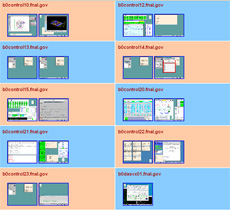Screen shot program fosters cross-globe collaboration

CDF collaborators can remotely view 20 online screen images of the 10
control room computers updating regularly.
Although an ocean divides teams of CMS researchers, the CMS collaboration has worked to make researchers forget about that distance.
"If you want to find out what is happening with an experiment, you go to the control room," said Erik Gottschalk, head of the LHC Remote Operations Center at Fermilab. "To work with someone at CERN, it helps to see what they are looking at."
But firewalls at some laboratories prevent network sharing, and commercial screen sharing systems require a timely program download and visual delays of up to two minutes. Letting collaborators view the same control room data screens almost instantly from laboratories in America, Europe, Asia and even from home, became a priority for CD's Kurt Biery.
With the help of Kaori Maeshima, who works on CMS and CDF, Biery got around both problems with a new screen snapshot program that captures images of data and detector monitors and publishes the images on outside Web servers. Images broadcast in 5 or 60 second increments. Safeguards prevent outside viewers from changing data on the
screens.
"It is a very handy, safe way for collaborators around the world to see what
we are doing and to help us with our problems," said J.J. Schmidt, CDF
operations manager. "It's a great tool when training graduate students. Rather than having
them try and describe the problem, both look at the same screen in the control room."
CDF simultaneously posts screen captures from all 20 control room screens. CMS has been experimenting with the system and will share data among all three of its control rooms.
The screen captures don't require additional programming from control room
staff as a read-only system would. Eventually, Biery wants to add user tools such as the
ability to search archived screens or freeze images for longer viewing. Ideally, collaborators could review the last eight hours of remote operation during meetings.
"We could look at it and discuss it, that bridges the gap that way," Gottschalk said.
--Tona Kunz
|